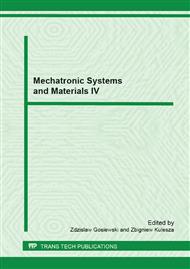p.445
p.451
p.457
p.467
p.473
p.483
p.489
p.495
p.501
Diversity of Servo-Constraint Problems for Underactuated Mechanical Systems: A Case Study Illustration
Abstract:
Underactuated mechanical systems are systems with fewer control inputs than degrees of freedom. Determination of an input control strategy that forces an underactuated system to complete specified in time outputs (servo-constraints), whose number is equal to the number of inputs, can be a challenging task. Diversity of the servo-constraint problems is discussed here using a simple spring-mass system mounted on a carriage (two degrees of freedom, one control input, and one specified in time output). A formulation of underactuated system dynamics which includes the output coordinates is motivated, with the governing equations arising either as ODEs (ordinary differential equations) or DAEs (differential-algebraic equations). Solutions to the servo-constraint problem are then discussed with reference to so-called non-flat systems (with internal dynamics) and differentially flat systems (no internal dynamics). Some computational issues related to the ODE and DAE formulations are finally discussed, and relevant simulation results for the sample case study are reported.
Info:
Periodical:
Pages:
473-482
Citation:
Online since:
March 2013
Price:
Сopyright:
© 2013 Trans Tech Publications Ltd. All Rights Reserved
Share:
Citation:


